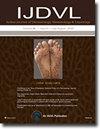手持窄带紫外线B装置治疗白癜风的临床疗效和安全性分析——系统回顾和荟萃分析。
摘要
手持式窄带紫外线B (NB-UVB)设备是一种用于白癜风的便携式、家用、患者友好型设备。这是一种较新的有希望的治疗方法,由于研究的异质性,缺乏普遍的共识。目的探讨手持NB-UVB装置治疗白癜风的临床疗效和安全性。方法与材料按照PRISMA指南,使用合适的关键词,于2023年11月28日检索Embase、PubMed和Scopus数据库。从纳入的研究中提取了患者再色素沉着百分比和毒性比例的数据。随机效应和固定模型通过荟萃分析产生汇总估计。结果在250篇文章中,纳入了13项研究(557例患者)。在中位持续时间6个月(范围3-12个月)内,分别有63.6% (95% CI: 51.0-75.3%)、40.8% (95% CI: 30.4-51.6%)和15.4% (95% CI: 7.6-25.3%)的患者实现了>5 %、> 50%和>75 %的重色素沉着。治疗12周后,达到> 25%、> 50%和>75%的患者重新色素沉着的比例分别为31.1% (95% CI: 9.6-58.3%)、12.9% (95% CI: 3.1-28.1%)和6.5% (95% CI: 1.7-14.1%)。同样,在24周时,这些比例分别为53.2% (95% CI: 24.5-80.7%)、36.7% (95% CI: 15.8-60.5%)和11.1% (95% CI: 2.9-23.7%)。以最小红斑剂量(MED)计算为基础的治疗没有显著优于不计算MED的治疗(p = 0.43)。与包括活动性或缓慢进展性白癜风的研究相比,只有稳定型白癜风患者的研究没有显著提高> 25% (p = 0.06)、> 50% (p = 0.80)和> 75% (p = 0.25)的再色素沉着。每周3次治疗可显著提高> 50% (p < 0.01)和> 75% (p = 0.01)的再着色率。总共有11.3%(38/334)的患者对治疗无反应。最常见的不良事件是红斑,占33.4% (95% CI: 19.3-49.2%), 3级红斑27例,4级红斑15例。其他不良事件包括瘙痒、灼烧、色素沉着、干燥和水疱形成,分别见于22.1%、16.4%、19.1%、9.8%和9.7%的患者。结论当治疗频率为每周3 ~ 4次时,手持NB-UVB便携式家用设备在治疗白癜风患者时是一种安全有效的治疗选择,即使没有MED计算。Background Handheld narrowband ultraviolet B (NB-UVB) device is a portable, home-based, patient-friendly equipment used in vitiligo. It is a newer promising treatment that lacks generalised consensus due to heterogenicity among studies. Objective To determine the clinical efficacy and safety profile of handheld NB-UVB devices in the treatment of vitiligo. Methods Following the PRISMA guidelines and using appropriate keywords, the Embase, PubMed and Scopus databases were searched on 28 November 2023. Data on the proportion of patients with a percentage of re-pigmentation and toxicity were extracted from the included studies. Random effects and fixed model were utilised to generate pooled estimates via meta-analysis. Results Out of 250 articles, 13 studies (557 patients) were included. The extent of repigmentation achieved over a median duration of 6 months (range 3-12 months) was quantified to be > 25%, > 50%, and >75 % in 63.6% (95% CI: 51.0-75.3%), 40.8% (95% CI: 30.4-51.6%) and 15.4% (95% CI: 7.6-25.3%) of patients respectively. After 12 weeks of treatment, the proportions of patients achieving > 25%, > 50%, and >75% re-pigmentation were 31.1% (95% CI: 9.6-58.3%), 12.9% (95% CI: 3.1-28.1%) and 6.5% (95% CI: 1.7-14.1%), respectively. Similarly, at 24 weeks, these proportions were 53.2% (95% CI: 24.5-80.7%), 36.7% (95% CI: 15.8-60.5%), and 11.1% (95% CI: 2.9-23.7%). Minimal erythema dose (MED) calculation-based therapy was not significantly better than therapy given without MED calculation (p = 0.43). The studies with only stable vitiligo patients did not achieve significantly greater > 25% (p = 0.06), > 50% (p = 0.80), and > 75% (p = 0.25) re-pigmentation compared to the studies that also included active or slowly progressive vitiligo. Three sessions per week resulted in significantly higher > 50% (p < 0.01) and > 75% (p = 0.01) re-pigmentation. Totally, 11.3% (38/334) of patients showed no response to therapy. The most commonly reported adverse event was erythema in 33.4% (95% CI: 19.3-49.2%) of patients, with grade 3 and 4 erythema in 27 and 15 patients, respectively. Other adverse events included pruritus, burning, hyperpigmentation, dryness, and blister formation observed in 22.1%, 16.4%, 19.1%, 9.8%, and 9.7% of patients, respectively. Conclusion Handheld NB-UVB portable home-based devices are an efficacious and safe treatment option in vitiligo patients even without MED calculation, when the treatment frequency is three to four sessions per week.

 求助内容:
求助内容: 应助结果提醒方式:
应助结果提醒方式:


